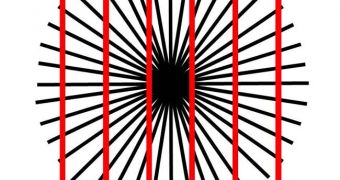The human brain only makes sense of the images we are seeing about one-tenth of a second after light hits the retina, meaning that in fact our visual system is somehow impaired by neural lag, for which the brain must compensate. How this is done is still under debate, with some scientists proposing that the motor system could be able to compensate by offsetting the delay. The same lag could be what makes our brain perceive certain images as optical illusions, says Mark Changizi from the Rensselaer Polytechnic Institute in a recently published study.
Changizi reckons that in fact the visual system compensates for the neural delay by generating images corresponding to a time one-tenth of a second into the future. Thus instead of seeing an image one tenth of a second into the past, foresight compensates so that we view the surroundings as they are in present time.
"Illusions occur when our brains attempt to perceive the future, and those perceptions don't match reality", Changizi said.
For example, when a person watches the Hering illusion (see picture) the geometric shapes they are observing leave them the impression that they are moving forwards and towards the central point where the spoke-like lines meet. In an attempt to predict the image the eyes are seeing, the brain distorts this image by projecting the straight vertical lines as curved in the vicinity of the central point, as they would appear if one actually moved towards them.
"Evolution has seen to it that geometric drawings like this elicit in us premonitions of the near future. The converging lines toward a vanishing point (the spokes) are cues that trick our brains into thinking we are moving forward - as we would in the real world, where the door frame (a pair of vertical lines) seems to bow out as we move through it - and we try to perceive what that world will look like in the next instant", Changizi said.
In reality, the image of the objects surrounding us doesn't change just in shape, but it is also correlated with the angular size, speed of travel and contrast, amongst others. You can make better notice of the effect while walking towards two objects standing in front of you. You will immediately see how the shape, angular size and contrast change as you draw nearer to the objects and how the objects appear blurred as the traveling speed increases.
With the help of the visual system lag compensation, Changizi could explain how several types of illusions occur and created a matrix of 28 categories containing about 50 types of illusions through which certain variable can be predicted.
"The theory is a big new player in the debate about the origins of illusions. All I'm hoping for is that it becomes a giant gorilla on the block that can take some punches", concluded Changizi.

 14 DAY TRIAL //
14 DAY TRIAL //